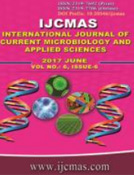


 National Academy of Agricultural Sciences (NAAS)
National Academy of Agricultural Sciences (NAAS)

|
PRINT ISSN : 2319-7692
Online ISSN : 2319-7706 Issues : 12 per year Publisher : Excellent Publishers Email : editorijcmas@gmail.com / submit@ijcmas.com Editor-in-chief: Dr.M.Prakash Index Copernicus ICV 2018: 95.39 NAAS RATING 2020: 5.38 |
The effect of Aluminum toxicity on seed germination and other biochemical parameters of two varieties of Barley (RD2052 and RD2552) differing in their sensitivity to aluminum toxicity were studied. In present study different concentrations of Al (Control, 2mM, 4mM and 6mM) were used to impose Aluminum toxicity under in vitro condition and amelioratingrole of Salicylic acid and Ascorbic acid by seed priming method was studied. The complete experimental set was classified into three categories viz. (i) unprimed seedlings with Aluminum treatment; (ii) Ascorbic acid Primed seedlings with Aluminum treatment and (iii) Salicylic acid primed seedlings with Aluminum treatment. The seeds were germinated under in vitro condition for six days. After six days of germination, seedling parameters (Root length, Shoot length, Plant height, Fresh matter, Dry matter), Photosynthetic pigments (Chl a, Chl b, Total Chl, Carotenoids), biochemical parameters (Total sugar, Reducing sugar, Total soluble protein), enzymes of carbohydrate metabolism (Invertase, Sucrose synthase and α-amylase) and enzymes of Protein metabolism (Nitrate Reductase and Protease)were analyzed. RD2052 was more affected under Al stress due to its susceptible nature, while RD2552 showed better result and performed tolerant nature against Al toxicity. All data were analyzed by the one way analysis of variation (ANOVA).
 |
 |
 |
 |
 |